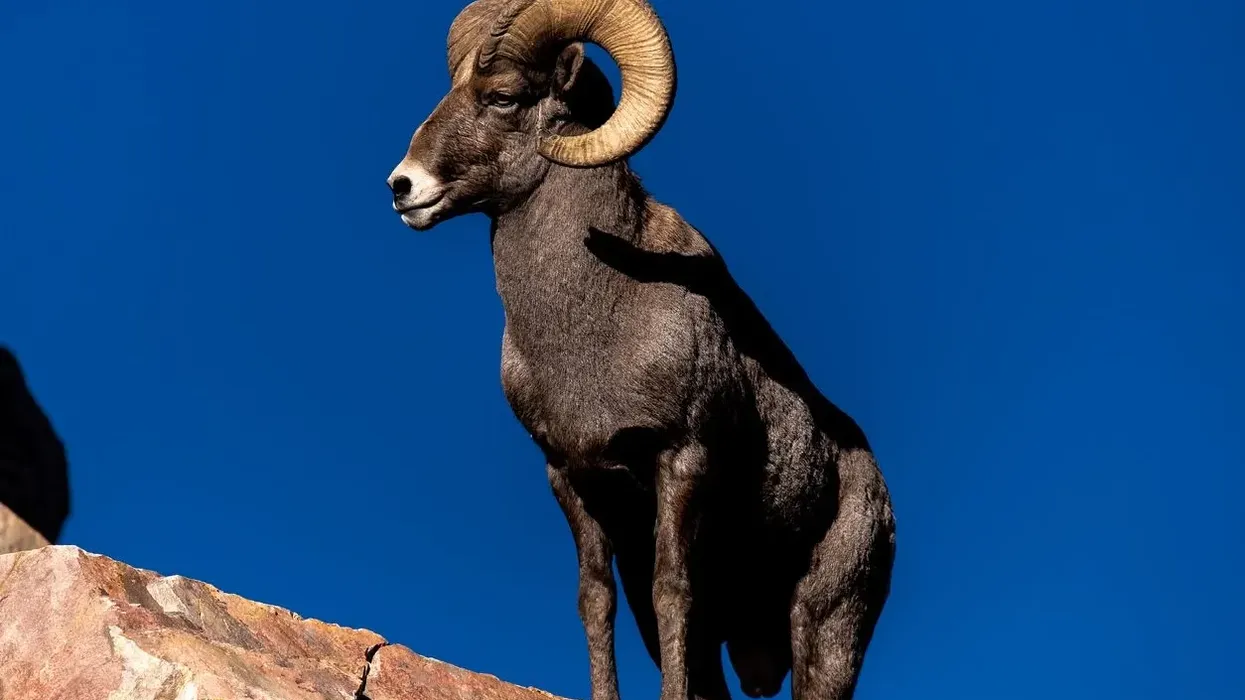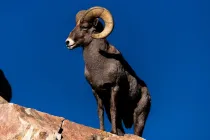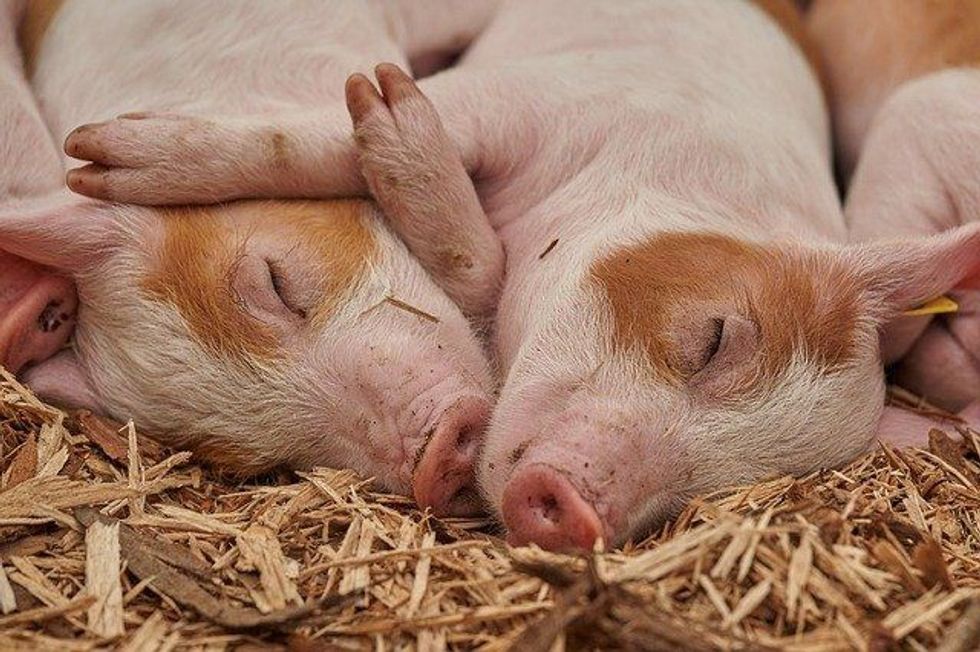Mountain sheep, more popularly known as the bighorn sheep (Ovis canadensis), are sheep with impressive climbing skills, unlike any other sheep. Their horns are a special trait that has helped them earn their name, the 'bighorn sheep' (Ovis canadensis). Their distinct large horns make it easier to identify these mountain species.
Bighorn sheep (Ovis canadensis) is a North American sheep breed. It gets its name from its colossal horns.
It adjusts very well to conditions of high elevations and low temperature. Their range stretches from the Brooks Range in northern Alaska, where Dall sheep live, to Death Valley, California, where desert bighorn sheep live.
Ovis canadensis has three separate subspecies, of which Ovis c. sierrae (according to recent genetic studies) is close to extinction. This animal initially crossed the Bering Land Bridge from Siberia to North America and became a part of Native American mythology.
The Spanish explorer Coronado, who saw bighorn sheep in the vicinity of California in 1540, said, 'sheep the size of horses, with large horns and short tails. I've seen some of their horns, and the height of them was incredible.'
Wild sheep in North America are linked to Asia's native sheep and domestic sheep (Ovis) population introduced from Europe by early settlers.
A wild sheep, similar to today's Marco Polo sheep of Central Asia, migrated into North America about half a million years ago through the Bering Land Bridge.
When the ice age glaciers spread south from their polar centers, the species got stranded in two ice: free zones, one in central Alaska and the other in the lower 48 states of the U.S, south of the Columbia and Snake rivers.
Sheep in the Alaskan refugium became the slender-horned Dall sheep (Ovis Dalli), while those farther south became the heavy-horned rocky mountain and desert bighorns (Ovis canadensis).
The northern bighorn sheep extended their range east to the Mackenzie Mountains and south to the Peace River in Northern British Columbia when the ice sheet receded 10,000-20,000 years ago.
If you enjoyed our article on the bighorn sheep, do go through our sheep facts and Merino sheep facts.
Mountain Sheep Interesting Facts
What type of animal is a mountain sheep?
This animal is a type of wild sheep that is much larger in size than normal sheep.
What class of animal does a mountain sheep belong to?
Mountain sheep (bighorn sheep) belongs to the class of Mammalia, which is a stocky, hoofed animal that is about 150% larger than domestic sheep.
How many mountain sheep are there in the world?
Bighorn sheep population was expected to range between 1.5-2 million in North America at the turn of the 19th century, but there are only less than 70,000 left today.
Where does a mountain sheep live?
The bighorn sheep range stretches from the Canadian Rockies' snowfields to the desert floor of Death Valley, California, and Alaska to northern Mexico.
What is a mountain sheep's habitat?
The bighorn sheep of western North American mountains adjust very well to conditions of high elevations and low temperature. Bighorn sheep inhabit colder mountainous areas of Canada and the United States, such as the Rocky Mountains and the Sierra Nevada.
The desert bighorn sheep subspecies, on the other hand, are native to dry desert environments. Rocky cliffs and bluffs are all popular habitats for bighorn sheep. Females and males spend summer in different meadows on alpine ranges, followed by young and juvenile rams after the mating season.
Who do mountain sheep live with?
This species of sheep (bighorn), like other cattle species, live in herds.
How long does a mountain sheep live?
The female bighorn sheep's life span ranges from 15-16 years, whereas rams have a life span that rarely goes past 12 years.
How do they reproduce?
Lambs are born in Canada between early May and mid-June. Normally, each ewe has only one lamb, but twins do occur sometimes.
The ewes leave their flock to give birth to her lamb in a secluded gully or canyon. After two or three days, the lamb will easily pursue its mother, although unsteadily.
Sheep are gregarious creatures, and the ewe returns to her herd of 10 or more ewes, lambs, yearlings, and immature rams soon. While wild sheep live in herds, rams and ewes usually only meet to mate.
Females live in herds of other females and their young rams, while rams live in bachelor groups. When fall mating season begins, rams congregate in larger numbers, and ram combat becomes more intense and can be heard from a mile away.
Only older, tougher rams with bigger curved horns win this fight to mate. The young ram is nursed for 4-6 months by its mother ram.
What is their conservation status?
When it comes to their conservation status, the IUCN has listed these rams as Least Concern based on their populations. An estimated population of 150,000-200,000 sheep was projected in the 19th century.
Their populations declined due to unrestricted hunting, predators, habitat loss, rangeland overgrazing, and diseases acquired from domestic livestock. Despite their predators and hunting, the population of this sheep made a recovery. There are more than 70,000 of these species today.
Mountain Sheep Fun Facts
What do mountain sheep look like?
Bighorn sheep's coats range from dark brown to grayish brown in the northern mountains to a light tan in the desert. Its belly, rump, and muzzle are all white. It's most famous for its massive horns. The horns of the bighorn ewes are thinner and less curved. Rams have broad and curved horns.
How cute are they?
The Rocky Mountain bighorn sheep is cuter than other species, especially when they are little lambs.
How do they communicate?
Considering the traits of bighorns, we come to the conclusion that the Ovis dalli sheep uses bleating. Bleating (sound of a 'baaaa') is primarily used for contact communication, especially between the dam and the lambs, though it is often used between other flock members on occasion.
Specific sheep's bleats are different, allowing the ewe and her lambs to distinguish one another's vocalizations.
How big is a mountain sheep?
Males stand 35–41 in (90–105 cm) at the shoulder and measure 63-73 in (160-185 cm) from nose to tail. Females are typically 30-35 in (75–90 cm) tall, and 50-62 in (127-158 cm) long. These animals are about 1.5 to two times bigger than cattle goats or an average ram.
How fast can a mountain sheep run?
The Mountain sheep, using their hoofed feet, can run at speeds of about 15 mph (24 kph).
How much does a mountain sheep weigh?
Males normally weigh between 128-315 lb (58-143 kg). Females normally weigh between 75-201 lb (34-91 kg). On average, the rocky mountain bighorn sheep will weigh around 300 lb (136 kg).
What are the male and female names of the species?
Male sheep are commonly referred to as rams, and female sheep are referred to as ewes.
What would you call a baby mountain sheep?
Baby bighorns are referred to as lambs.
What do they eat?
Bighorn sheep in wildlife graze on grasses, clover, and sedges in winter. In winter, it resorts to eating woody plants like willow and sage. Bighorn sheep are known to feed holly and cacti in desert areas.
Are they dangerous?
Bighorn sheep don't attack humans. However, during mating seasons, they are generally aggressive, and it would be wise to stay away from them.
Would they make a good pet?
Bighorn sheep can not be domesticated. It prefers living amidst other wildlife.
Did you know...
The size of a horn of a bighorn sheep is a sign of respect for bighorns. In males, horns can weigh up to 30 lb (13.6 kg). Bighorns, though, might look similar to goats but are a completely different species from mountain goats.
A significant population of bighorns can be spotted in national parks, wildlife sanctuaries, or roaming in their natural wildlife habitat, depending upon whether it is summer or winter.
Bighorn sheep are lighter in color and much smaller than ram.
Mountain sheep keep themselves from falling off because they were built to climb elevated areas. Their hooves dig into the rocks and help them climb. These hooves have mild patterns that act like climbing shoes, helping them pinch their feet into rocks.
Different types of mountain sheep
The four sheep species are rocky mountain bighorn, desert bighorn (Ovis canadensis nelsoni), stone sheep, and Dall sheep, which range from Yukon, territories of the Northwest, and Alaska to the deserts of old Mexico.
What is the difference between mountain goats and mountain sheep?
The mountain goats are found at higher elevations than bighorn sheep. When you compare the horns of these two sheep, you'll see that the mountain goats' horns are thinner, sharper, and swept backward but not curled.
How do mountain sheep keep from falling?
The strong, bony skull of the animal normally protects it from severe injury. These animals are lean but have strong muscles to help them in climbing.
The separated hooves of bighorn sheep have a rugged rim, which allows their feet to grip rocky terrain. To maintain power while climbing, bighorn sheep ascend the steep terrain diagonally in a 'Z' shape.
Here at Kidadl, we have carefully created lots of interesting family-friendly animal facts for everyone to discover! Learn more about some other mammals, from our Asian elephant facts and Pudelpointer facts pages.
You can even occupy yourself at home by coloring in one of our free printable mountain sheep coloring pages.









